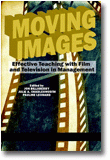
Moving Images
Effective Teaching with Film and Television in Management
Edited by:
Jon Billsberry, Deakin University
Pauline Leonard, University of Southampton
Published 2012
This book will inspire academics, teachers and trainers to use film and television in their classrooms and to shows them how it might be done. It brings together respected international scholars who recount their experiences of how they have used moving images in their classrooms (defined widely to include distance-learning) with their explanations of why they chose this method of teaching and how they put their intentions into action.
The book also illustrates how particular subjects might be taught using film and television as an inspiration to demonstrate the range of opportunities that these media offer. Finally, this book considers some of the practical issues in using film and television in the classroom such as copyright, technology, and the representation of reality and drama in films.
This is a ‘practical, how to’ book that answers the questions of those people who have considered using film and television in their classroom but until now have shied away from doing so. The opportunity to see how others have used film effectively breaks down psychological barriers and makes it seem both realistic and worthwhile.
CONTENTS
Die Another Day: Teaching With Film and Television in the Management Classroom, Jon Billsberry, Pauline Leonard, and Julie Charlesworth. SECTION ONE: INSPIRATIONAL EXEMPLARS. Viewing Organizational Behavior, Management Concepts, and Theories Through Film, Joseph E. Champoux. Art Movies in the Classroom, Thomaz Wood Jr. Research as Detective Work: Using Film With Postgraduate Students, Richard Thorpe and Mark Easterby-Smith. The Unique Effects of Animated Film in Teaching and Learning Environments, Joseph E. Champoux. Expect the Unexpected, Janet Sutherland. Cops, Robbers and Masked Vigilantes: Teaching Through Representations of Crime, Craig Webber. Getting To “So What?” Stephen B. Sloane. SECTION II: CRITICAL ISSUES. Using Feature Films as Critical Documentary in Management Education, Pauline Leonard. Understanding Audiences, Emma Bell. The Drama of Films, Andres Fortino. Using Moving Images in Management Education: Technology, Formats, Delivery and Copyright, Joseph E. Champoux and Jon Billsberry. SECTION III: IMAGINING INCLUSION. Using Film to Contextualize the Teaching of Public Involvement, Julie Charlesworth. To Boldly Go Where Few Have Gone Before: Teaching Strategy With Moving Images, Véronique Ambrosini, Jon Billsberry, and Nardine Collier. Using Film in the Teaching of Strategic Decision-Making, Peter Galvin and Troy Hendrickson. Using Visual Media to Teach Recruitment and Selection, Jon Billsberry. Using Movies to Teach Business and Leadership Principles, Troy Hendrickson and Peter Galvin. Contributors.
REVIEWS
"Moving Images succeeds at its core mission: to convey best practices in using media in the classroom and make it evident that such methods offer great benefits to educators and students alike." John A. Cantone in Contemporary Psychology
-
Paperback978-1-61735-874-6
Web price: $45.04 (Reg. 52.99)
-
Hardcover978-1-61735-875-3
Web price: $80.74 (Reg. 94.99)
- eBook978-1-61735-876-0

- EDU041000 - EDUCATION: Distance & Online Education
- EDU037000 - EDUCATION: Research
- BUS030000 - BUSINESS & ECONOMICS: Human Resources & Personnel Management
-
 (Re)Envisioning Social Studies Education Research
Current Epistemological and Methodological Expansions, Deconstructions, and Creations
(Re)Envisioning Social Studies Education Research
Current Epistemological and Methodological Expansions, Deconstructions, and Creations
-
 American Educational History Journal - Golden Anniversary Edition
Volume 50 Numbers 1 & 2
American Educational History Journal - Golden Anniversary Edition
Volume 50 Numbers 1 & 2
-
 Distance Learning
Volume 20 #3
Distance Learning
Volume 20 #3
-
 Distance Learning
Volume 20 #4
Distance Learning
Volume 20 #4
-
 Faculty Development
Achieving Change Through Action Research
Faculty Development
Achieving Change Through Action Research
-
 Qualitative Research With Diverse and Underserved Communities
Qualitative Research With Diverse and Underserved Communities
-
 Quarterly Review of Distance Education
Volume 24 #1
Quarterly Review of Distance Education
Volume 24 #1

